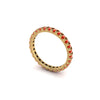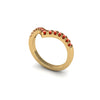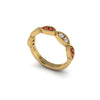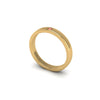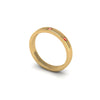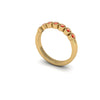Yellow Gold
Yellow gold is simply 24K pure gold, usually sold as bars or ingots. However pure gold is not suitable for jewelry, as it dents and twists easy (it scores 2.5 on the Mohs scale of hardness). Silver is usually alloyed with gold in different amounts to stabilise jewelry pieces.
Such mixtures of gold with silver are graded by karat*. 14 karat gold, at the lowest end, contains 58.3% gold and 41.7% silver. It is suitable for everyday wear, as the silver confers hardness and durability. The highest grade commonly used for jewelry is 22 karat gold, with 91.7% gold and 8.3% silver. This is used for engagement and wedding jewelry.
*To differentiate from carats that are a measure of weight of Diamonds, the measure of purity of gold is spelt as karats.
Rose Gold
Rose gold is an alloy of pure 24 karat gold with copper and silver, first used by the Russian royal jeweler Carl Faberge. It is valued as a subtle, romantic color compared to yellow gold. It became popular after the invention of the trinity ring - which uses three intertwined rings of rose, white and yellow gold. The rosiness of rose gold is determined by the ratio of gold to copper. 14K rose gold (58.3% gold, 33.5% copper and 8.2% silver) is rosier than color of 18K rose gold (75% gold, 22.2% copper and 2.8% silver).
White Gold
White gold is yellow gold alloyed with 'white' metals like nickel, zinc or palladium, which give both hardness and lightness. 14K white gold contains 58.3% gold and 41.7% white metal; nickel- or zinc-based white gold alloys are cheaper and 'whiter' than palladium-based gold alloy, which is preferred by some for its greyer shades resembling platinum. Palladium alloy is also suitable for those whose skin is sensitive to nickel.
Another way to make white gold is to coat gold with rhodium - a hard, shiny, white metal. Its sparkle and resistance to scratching make it preferable to many compared to alloyed gold. However, rhodium white gold rings cannot be resized as the process damages the coating.
Platinum
Platinum is the rarest metal used in jewelry, and a lot more expensive than gold. Compared to gold, it can be used at 95% purity, giving platinum jewelry a very high resale value. Since it contains no copper or silver alloy, platinum is also hypoallergenic, i.e. wearing platinum jewelry causes no allergic reaction. Platinum is 60% heavier than gold, highly heat-resistant, and extremely dense, making it exceptionally durable. While it can scratch like other precious metals, these scratches do not result in material loss. Platinum, a noble metal, resists tarnish and discoloration from chemicals. Its strength and white lustre make it a popular choice for jewelry and gemstone settings. Its hardness (4.5 on the Mohs scale) and density also make it a tougher metal than gold, and its rarity makes it very desirable for wedding and engagement jewelry.

